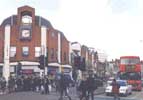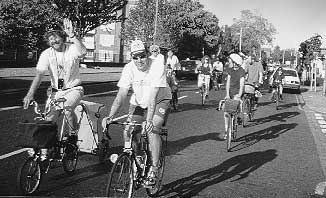|
|
|
| Home |  |
|
|
|
|
|
|
|
|
|
|
Critical
Mass Comes to Ealing The
West London Critical Mass Ride is a pleasant evening ride usually
involving 30+ cyclists. The venue is Shepherds Bush Green, western
end, 5.45/6pm, second Friday of every month. A recent ride went
though Acton, quietening the High street for a few precious minutes
How would
you spend £200,000 ? In August 1996 Ealing Borough Council
was listed in the London Cyclist has having the most money allocated
to cycling at present of any London Borough - £200,000 per
year. It is our job to see they spend it wisely. Funds allocated
for cycling last year have been spent on the new Toucan crossing
(a Pelican crossing for cycles) at Northfields Av, and some
other minor improvements have appeared in the last few months like
the strange on-pavement cycle path leading eastwards down the Uxbridge
Road from Ealing Broadway. As usual, it stops when you most need
it. In 1996/7,
the Common will receive a Toucan crossing where it meets Uxbridge
Road, as will Elm Tree Clo. and Kensington Rd, Southall. An
advisory track is being put in on Horsenden Lane South. The Borough
has announced a programme of Advanced Stop Lines for cyclists up
and down the Uxbridge Rd, with Steyne Rd/Uxbridge Rd likely to be
the first to be built. We are trying to ensure these are built correctly,
as money allows. The Ironbridge
junction in Southall is being rebuilt and now has a short stretch
of pavement cycle lane; the road is constrained by the narrow bridge
and more provision is planned. For 1997/8,
the Council wants to spend £562,000, notably on 300metres
of cycle lanes on the Uxbridge Road between Southall and Iron Bridge,
plus seven more Toucan crossings and more Advanced Stop Lines. Sadly one
road calming scheme has resulted in a serious accident to a
cyclist at Southfield Rd, Acton W4. Road narrowing forces cyclists
out into the path of vehicles, and it's worrying that dangerous
traffic calming measures from earlier years are still in place.
Please continue to report back on dangerous or inconvenient layouts
and schemes. Contact: Simon Batterbury Error! Bookmark not defined. DOT-ty Junction
The Department of Transport have re-built the Hangar Lane / Uxbridge
Road junction. Despite a request from Ealing Council for cycle lanes
and Advanced Stop Lines, the DOT made no provision at all for cyclists.
The junction was completed in the same week that Transport minister,
Sir George Young announced his aim of doubling the number of bicycle
journeys by the year 2000. Although the DOT says all the right things,
it too often fails to convert words into actions. Please give us
your views on the new junction lay-out, which we are passing directly
to the Traffic Director for London. National
Bike Week Cycling began the summer with a high profile, as National
Bike Week took place in early June 1996. Our 'Dr Bike' session on
Ealing Green attracted about 30 customers for post-coding their
frames and basic repairs. Thanks to everyone who helped, particularly
Simon Wadmore for the loan of a magnificent penny farthing and Chris
Noble for a 1910 bicycle. We got front page coverage in the Gazette
and the Recorder. Ol organised
an excellent eight mile ride around the Borough, which coincided
with the launch of the new Ealing cycle map (available from libraries
and Council offices). Some 64 people joined the ride, including
numerous Council officials. The Cycle
Challenge project at Thames Valley University is gearing up
to autumn events. Fifteen staff and students have won free bikes
as part of our plan to publicise sustainable transport at the University.
We are trying to get a 'celebrity' to give these out as prizes in
October. New cycle racks are being put in around campus this summer,
and there are signs of a change in attitude on campus. Error! Bookmark
not defined. for project report. Ealing recently
published its Pollution Control Monitoring Report for 1995.
It estimates that 80-90% of nitrogen dioxide in London arises from
road vehicles, and that levels at traffic blackspots are around
the recommended maximum. Nitrogen dioxide irritates the lungs, particularly
of asthmatics. It is a greenhouse gas, and it is involved in chemical
reactions that spread ozone over a wide area around London. Benzene levels
are particularly concerning. It is known to cause cancer, and the
Government Expert Panel on Air Quality Standards advises that there
is absolutely no level at which it is safe, and that recommended
levels should be reduced steadily. At most monitoring locations
in Ealing, these upper limits are regularly crossed, especially
where they are near roads - 80% of benzene in the air comes from
vehicle emissions. Ozone is more
complicated, as it is caused by reactions between substances including
nitrogen dioxide and organic pollutants, particularly in the hot
dry conditions of this and last summer. In 1995, World Health Organisation
guidelines were exceeded on 34 days. Sadly, increasing ozone at
street level increases respiratory disease, but does nothing for
the holes in the ozone layer. Particulates
are another concern. However, Ealing has only been monitoring them
generally. Evidence suggests that those below 10 microns in diameter
are the most hazardous, and these come principally from diesel exhaust.
In future, these PM10s will be monitored in Acton specifically. There is some
debate about the health effects of air pollution. The prevalence
of asthma is increasing across the West, even in places where there
is very little vehicle traffic. It is therefore unlikely that increased
pollution from vehicles is a major cause of this increase. There
is, however, very little doubt that traffic pollution aggravates
the asthma in the increasing numbers of people suffering from it. Ealing has
also published its Health Strategy, in partnership with the
Ealing, Hammersmith and Hounslow Health Agency. This is tackling
the ten most important health problems in the area. One is air pollution.
The solutions are well known to us all, based on reducing reliance
on vehicles. Another target
is for prevention of coronary heart disease and stroke, for which
increasing physical activity is an important part. Another is to
reduce accidents, and the effects of accidents. Maintaining exercise
into middle age reduces the risk of fractures. Although cycling
is mentioned as a solution to air pollution, it is not yet seen
as a priority in reducing accidents. What can we make of these documents? That there are people around who have a wide range of problems, to which one solution is making cycling in Ealing more accessible and safer. These publications give a lot of support to our aims. |
